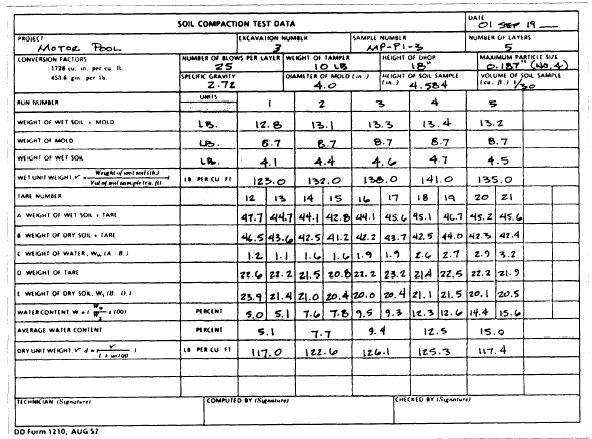|
Sample Preparation and Compaction Procedures About five specimens, containing successively increasing
moisture contents, are needed to determine
the OMC at which the maximum density for
a given compactive effort will occur. For the Proctor mold, about 6 pounds for
each specimen (about 30 pounds total) is needed. For the CBR mold, you will need
about 12 to 14 pounds per specimen, or about 60 to 70 pounds total.
Before the compacting begins,
the sample is air-dried and a moisture content of the air-dried material is
determined. Airdrying is done by spreading out the material in the sun or in
front of an electric fan. The water content of the air-dried material is
determined as a basis for estimating the amount of water you need to add to each
trial specimen. The driest specimen should contain just enough water to produce
a damp mixture that crumbles readily. For each succeeding specimen, increase the
water content by about 2 percent until the wettest specimen is quite wet and
plastic.
The compaction procedures for nongravelly and gravelly
soils are the same with two exceptions. First, the
4-inch Proctor mold is used for fine-grained soil, and
the CBR mold is used for gravelly soil. Second, 25 tamper blows per layer are
used for the Proctor mold, and 55 blows per layer are used in the CBR mold. That
results in equal compactive efforts for the two mold sizes and soil volumes.
To compact the soil, you first attach the base plate
and collar to the mold. Then you fill the mold to the top of the collar with the
material placed in five equal layers, compacting each layer with the appropriate
25 or 55 equally distributed blows. After compacting the

Figure 13-2.Data sheet for
soil compaction test.
material, you remove the collar and weigh the mold and compacted
material. Then take moisture content samples from the top and bottom of the
specimen and determine the moisture content for each. If the two moisture
contents differ, use the average between them.
A modification of the above procedure uses a 5 1/2-pound
tamper and the material is placed in three equal
layers, rather than five; otherwise, the test is the same.
The procedures can be found in ASTM D 698.
|







